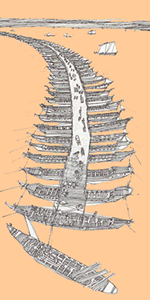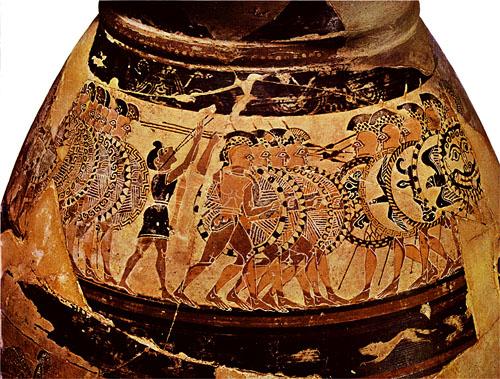
During the 6th century BC., under the leadership of three kings: Cyrus II, Cambyses II, and Darius I , the Persian Empire had spread over western Asia, Macedonia and Egypt, and encircled the Greek cities of Asia Minor, most of which submitted to Persian rule.
A revolt sprang up in Miletus, however, and these colonies appealed to Greece for aid.
Thus began the first Persian War, the Persians seeking both to subdue Athens and to strengthen its control of the Aegean area., sending an army of 25,000 to Attica in 490 BC, but was outwitted by an Athenian force of only 10,000 at the Battle of Marathon.
 Five years later, in 485 BC, Darius died, and his son Xerxes was left with the task of subduing Greece.
Five years later, in 485 BC, Darius died, and his son Xerxes was left with the task of subduing Greece.
His invasion of Greece in 480 BC was by both land and sea, fought by soldiers gathered from the entire Persian Empire. The Greek defence was led by a force representing 30 city states (though there were other Greek city states that sided with the Persians, including Delphi).
 Though the army and navy amassed to fight the Persians had as its strategist the Athenian leader Themistoklis, it was the Spartan King Leonidhas who led the army to the pass at Thermopylae. This pass, which was the main entry point into Greece from the north, was quite narrow, and thus easy to defend, but the Greeks were betrayed by a traitor who showed the Persians another route over the mountains.
Though the army and navy amassed to fight the Persians had as its strategist the Athenian leader Themistoklis, it was the Spartan King Leonidhas who led the army to the pass at Thermopylae. This pass, which was the main entry point into Greece from the north, was quite narrow, and thus easy to defend, but the Greeks were betrayed by a traitor who showed the Persians another route over the mountains.
Though Leonidhas and 300 of his elite Spartan troops fought to the death at the pass, the Persians entered Athens and burned it to the ground. Along with Greek defeat on land, came a victory in the Bay of Salamis, where the Greeks trapped the Persian navy in the narrow channel, and the following year there was a victory on land as wsell, in the Battle of Plataea.